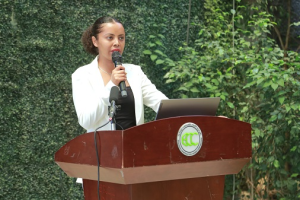
Mahlet Alemu, just gave birth to her third child at Yekatit 12 hospital recently. She gave birth to the previous ones also in hospital. She said that hospitals have significance to reduce hemorrhage and save the children during bring forth period. Zemzem Ahmed, Maternal Health Service at Ministry of Health on her part says research shows that majority of mothers lose their life during postnatal stage due to hemorrhage. Hemorrhage causes more than fifty percent of maternal deaths, she added.
‘’Blood pressure, abortion, long fever, and uncomfortable geographical location for mothers are other serious causes of the death. In regard to maternal death, 99 percent of the accident occurred in developing countries like Ethiopia. However, more than 80 percent of maternal mortality is preventable’’ according to Zemzem. As to her, studies in 2000 show that, Ethiopia has lost 871 mothers per 100,000 births. But, sixteen years later, the number decreased to 412 mothers from 100,000 mothers. While the Ministry prepared ‘’mentorship program’’ which help to win 199 from 100,000 mothers in the forthcoming 2020.
To achieve this program, the ministry has been a task to gathering information, and helping each other’s among departments. Mahelet Tilahun, Midwife at ‘’Yekatit 12 hospital’’ started work seven years ago with a diploma. Using the opportunity given by the government she has now upgraded her qualification to a bachelor’s degree. She recalls that, the number of midwifes in the hospital has quadrupled to 16 within the last seven years. According to the midwife, she entered the department due to her high interest to help mothers in particular and community in general in order to gain moral satisfaction.
Although the number of midwives increases from time to time, it does not mean that the hospital has adequate skilled workers. As to her, the existence of lack of attention on midwives, law salary, and the law number of midwifes, unfriendly work environment has serious factors which impede to more service provide. Particularly, to solve work environment problems, the hospital has built a new building which fulfill equipment, it has significant measurable action which help to serve maternal and children.
Azeb Admasu, Midwifery, physiotherapy, and Surgical Training Coordinator within Department of Human Resource Development Directorate at Ministry of Health says the Ministry has been working to reduce maternal and children mortality rate by deploying the experts in three ways, namely, primary, secondary, and Tertiary across the nation. According to Azeb, the main task of human resource development is maximize midwifes and deploying in different parts of the country.
For this end the ministry works in collaboration with Ministry of Education and Ministry of Science and Technology. Although the collaboration has played significant role to produce midwifes, the country has not adequate midwifes until now. Due to the existence of limitation of higher training institutions, lack of attention by both government and community, outdated training system, and lack of opportunities for midwifes to upgrade their skills are serious factors which hinders to produce adequate midwifes during the past many years in Ethiopia. In this regard, the country has a ratio of one midwife to 40,000 mothers. It was unexpected to serve mothers sufficiently due to the cause that midwifes become tired and overburdened.
To solve the problem, Ministry of Health has taken various measures during the past few years. Among these, providing training, inspection and supervision of health sectors, create strong linkage among stakeholders. On the other hand, the Ministry has prepared a short training strategic plan which is ‘’Accelerated Midwifery Strategy Plan’’ to produce 9,800 midwifes within three years, from 2012 to 2015. However it was achieved 4,674 in the stated period. Currently, Ethiopia has a ratio of one midwife to 12,000 mothers.
Although the action is measurable, it does not mean that succeed international standard, it was stated a ratio of one midwife to 6,000 mothers, she added. She further stated that, the increasing of universities from year to year, leaders’ commitment, well structure of the sectors, and existence of good communication among stakeholders are a good chance in order to produce efficient and adequate midwifes in the near future. Particularly, universities like Bahirdar, Gonder, Mekele, Arbaminch, and Hawassa have opened graduate training in midwifery, it was not expected during the past many years, it is rather they were not beyond diploma level.
The Ethiopian Herald May 11/2019
BY GETAHUN LEGESSE





